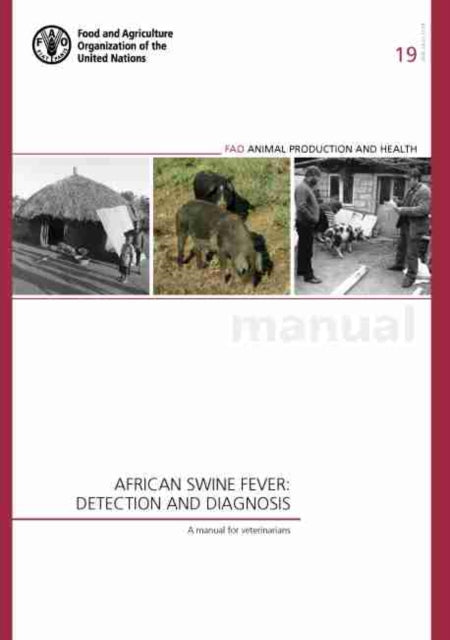Food and Agriculture Organization,Daniel Beltran-Alcrudo
African swine fever: detection and diagnosis, a manual for veterinarians
African swine fever: detection and diagnosis, a manual for veterinarians
YOU SAVE £23.20
- Condition: Brand new
- UK Delivery times: Usually arrives within 2 - 3 working days
- UK Shipping: Fee starts at £2.39. Subject to product weight & dimension
Bulk ordering. Want 15 or more copies? Get a personalised quote and bigger discounts. Learn more about bulk orders.
Couldn't load pickup availability
- More about African swine fever: detection and diagnosis, a manual for veterinarians
This manual provides information on diagnosing and responding to an outbreak of African swine fever, a severe threat to pig production systems. It covers the disease's causes, transmission pathways, and geographic distribution, as well as the different phases of an outbreak, from detection to laboratory confirmation. The best strategy for countries/zones free of the disease is to prevent entry through improved border control, awareness-raising, and better biosecurity, while infected countries must implement quick outbreak controls.
Format: Paperback / softback
Length: 85 pages
Publication date: 30 December 2020
Publisher: Food & Agriculture Organization of the United Nations (FAO)
This comprehensive manual provides detailed guidance on diagnosing and responding to cases or outbreaks of African swine fever (ASF). It serves as a vital resource for stakeholders involved in animal health, agriculture, and public health.
Epidemiology:
ASF is a highly contagious viral disease that affects pigs of all ages. It is primarily transmitted through direct contact with infected pigs or their bodily fluids, such as blood, saliva, or urine. The disease can also spread indirectly through contaminated food and water, as well as through contact with contaminated surfaces or equipment.
Transmission Pathways:
ASF has a complex transmission pathway that involves multiple hosts and environmental factors. The primary mode of transmission is through direct contact between pigs, which can occur in farms, slaughterhouses, or during transportation. The virus can also spread through contact with contaminated feed, water, or equipment, as well as through the movement of infected animals or their carcasses.
Geographic Distribution:
ASF is primarily found in sub-Saharan Africa, with recent outbreaks reported in several countries, including Nigeria, Kenya, and Tanzania. The disease has the potential to spread to other regions, particularly those with high pig populations and poor animal health management practices.
Phases of ASF:
ASF follows a specific chronology, from detection and diagnosis to laboratory confirmation. The different phases are outlined below:
Detection and Diagnosis:
Clinical Signs: ASF is characterized by a range of clinical signs that can vary depending on the age and immune status of the infected pig. These signs may include fever, lethargy, loss of appetite, coughing, and respiratory distress. In severe cases, pigs may develop haemorrhages, particularly in the skin, internal organs, and abdominal cavity.
Postmortem Findings: Postmortem examination is essential for confirming ASF diagnosis. Gross lesions, such as haemorrhages and necrosis, can be observed in the affected organs. Histopathological examination may also be performed to confirm the presence of ASF virus particles in the tissues.
Differential Diagnosis: Differentiating ASF from other pig diseases, such as blue ear disease or swine influenza, is crucial for accurate diagnosis. This may involve serological tests, such as enzyme-linked immunosorbent assays (ELISA) or immunohistochemistry, to detect the presence of ASF antibodies in the blood or tissues.
Laboratory Confirmation:
Main Techniques for Detecting Virus and Antibodies:
Virus Detection: ASF can be detected using a variety of laboratory techniques, including reverse transcription-polymerase chain reaction (RT-PCR) and real-time PCR. These techniques are highly sensitive and specific, allowing for the rapid identification of ASF virus in infected samples.
Antibody Detection: Antibody detection is also used to confirm ASF diagnosis. ELISA and immunohistochemistry are commonly used techniques for detecting the presence of ASF antibodies in the blood or tissues.
Management and Control:
Prevention:
The primary strategy for preventing ASF is to improve border control, awareness-raising, and better biosecurity practices. This includes measures such as implementing quarantine protocols, restricting the movement of pigs and their products, and implementing strict hygiene measures on farms.
Outbreak Control:
Infected countries will need to implement quick outbreak controls to prevent the further spread of ASF. This may include movement restrictions, stamping-out policies, and culling of affected pigs. It is also important to monitor the disease closely and implement surveillance systems to detect any new outbreaks.
Treatment and Vaccination:
Currently, there is no effective vaccine or treatment for ASF. However, research is ongoing to develop vaccines and treatments that can effectively control and prevent ASF outbreaks.
Conclusion:
ASF is a severe threat to pig production systems and has significant consequences on food security, international trade, and the livelihoods of pig producers and other actors in the supply chain. This manual provides detailed guidance on diagnosing and responding to cases or outbreaks of ASF, emphasizing the importance of prevention, outbreak control, and improved biosecurity practices. By implementing these measures, countries can effectively protect their pig populations and mitigate the impact of ASF on their economies and communities.
Weight: 198g
Dimension: 175 x 250 x 7 (mm)
ISBN-13: 9789251097526
This item can be found in:
UK and International shipping information
UK and International shipping information
UK Delivery and returns information:
- Delivery within 2 - 3 days when ordering in the UK.
- Shipping fee for UK customers from £2.39. Fully tracked shipping service available.
- Returns policy: Return within 30 days of receipt for full refund.
International deliveries:
Shulph Ink now ships to Australia, Belgium, Canada, France, Germany, Ireland, Italy, India, Luxembourg Saudi Arabia, Singapore, Spain, Netherlands, New Zealand, United Arab Emirates, United States of America.
- Delivery times: within 5 - 10 days for international orders.
- Shipping fee: charges vary for overseas orders. Only tracked services are available for most international orders. Some countries have untracked shipping options.
- Customs charges: If ordering to addresses outside the United Kingdom, you may or may not incur additional customs and duties fees during local delivery.


